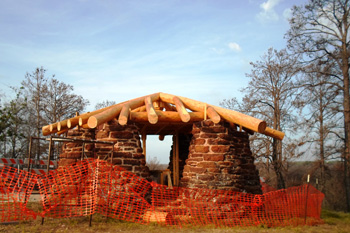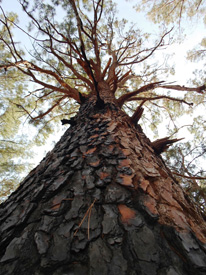Life After Wildfire: The Future of Bastrop State Park
The Bastrop County Complex fire ignited on September 4, 2011 and was the most destructive wildfire in state history. The 32,000-acre inferno destroyed over 1,600 homes and killed two people.
The Lost Pines Ablaze
High winds on September 4, 2011 directed fire quickly into Bastrop State Park, a beloved National Historic Landmark with structures built by the Civilian Conservation Corps (CCC) during the Great Depression.
Hundreds of defenders, including more than 140 TPWD employees, commercial partners, and firefighters from all over the country, battled the blaze. In the end, fire affected 96 percent of the approximately 6,565-acre park. Most notably, the fire had a significant impact on the Lost Pines ecosystem, an area of isolated loblolly pines and home to the endangered Houston toad.

The park's impressive structures that the CCC built with
native stone and pine were repeatedly threatened by
the ravaging blaze, but saved by preparation and quick
thinking by firefighters.

The Scenic Overlook is a true survivor. It is one of
two CCC structures that lost a wooden roof in the fire,
which has been reconstructed.
A Long Road to Recovery
It will take a generation or more for the Lost Pines to recover from this catastrophic wildfire. Despite this, the park is already showing new green and growth. Tiny loblolly pines dot the forest floor. Shrubs like yaupon and American beautyberry are once again providing berries for wildlife to eat. Animals large and small are once again making homes throughout the park. Although nature is regenerating some on its own, we still have work to do to help it along. Cleanup of the park is complete - now our eyes are turning toward the future of the pines.

Erosion continues to be one of the biggest issues in the park, as chunks of hillside are still sloughing off in heavy rains. Even light rains sweep soil away. Without stable ground and fertile soil, plants cannot take root. One of the first steps to reforestation is to stop erosion in the park.
Replanting the special "drought-hardy" loblolly pines began in the park and county in January 2013 and continue for at least five years. Both volunteers and contracted labor will continue to be called upon to plant the tiny seedlings–over two million in the park overall.
The Houston toad, an endangered species whose last stronghold was Bastrop State Park, suffered in the wake of the wildfire and drought. Only a handful of toads were documented in the park in 2012. These amphibians require a habitat with lots of tree canopy so only time can restore their home.
Prior to the wildfire, we utilized prescribed fire to manage the park's landscape. In the fall of 2014, we began conducting prescribed fire again. All of the drought- and fire-killed trees will eventually fall and provide fuel on the ground, which increases wildfire danger again. Low-intensity prescribed fire will clear out the dead fuel, keep the growth of oak trees in check and allow a new pine forest to flourish.

Members of American Youth Works' Environmental Corps
have played a huge role in the park's recovery by creating
trails, building bridges and supervising volunteers.

With plenty of space, water, and nutrients, loblolly
pines will thrive, as long as their territory is not
taken over by rampant oak growth.

Unfunded Aspects of Recovery
Take ownership in your state park. We still need funding for:
- Erosion Control – Without stable ground and fertile soil, plants cannot take root. One of the first steps to reforestation is to stop erosion in the park.
- Research – Our park has always been an outdoor classroom for students, but now it can serve as a place for biologists and other scientists to study fire's effects on birds, small mammals, vegetation and much more.
- Habitat Restoration/Reforestation – We have two million trees to purchase and plant over five years' time.
How You Can Help Bastrop State Park
There are four ways you can help with the ecological restoration of the park:
- Visit Bastrop State Park - Reserve a campsite, take a hike or sleep in a cabin. Over the next several decades, visitors have the unique opportunity to witness the rebirth of a pine forest. Each time you visit, there will be something new to explore.
- Mail a tax-deductible donation to support the Bastrop Recovery Project:
-
Texas Parks & Wildlife Department
Attn: Cashiers
4200 Smith School Rd.
Austin, TX 78744
On the memo line note: Bastrop Recovery Project--Habitat Restoration - If you would like to volunteer your time or donate specialty items for both the short- and long-term restoration and stewardship of the park, please contact the Lost Pines Complex Volunteer Coordinator at 512-237-2241, and provide your contact information and area of interest
- If you have suggestions or want to comment on the restoration and stewardship effort, please e-mail your remarks to: david.riskind@tpwd.texas.gov
-
Texas Parks & Wildlife Department
- Make a donation to the Friends of the Lost Pines State Parks
- This nonprofit fundraising and service group was organized to assist in the promotion, interpretation and operation of Bastrop and Buescher State Parks. For more information, visit the Friends of Lost Pines State Parks web site.
- Donate online to Restore the Lost Pines—Every $1 Plants a Pine Tree
- Bastrop State Park has partnered with the Arbor Day Foundation to restore the Lost Pines. Every $1 donated to The Lost Pines Forest Recovery Campaign plants a tree. You can also sign up for volunteer opportunities at the park through their website.
Related Information
